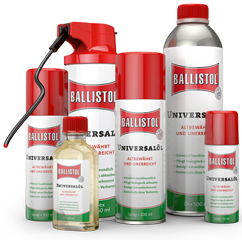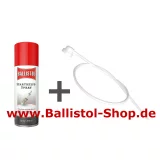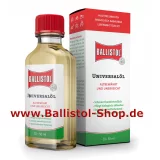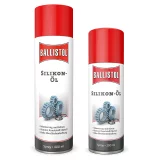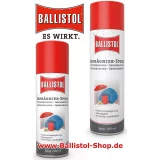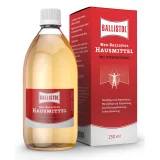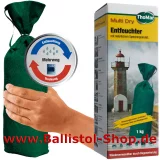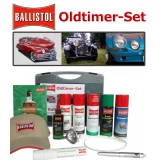Starting fluid
- Manufacturer: Ballistol
- Product No.: 25500
- EAN: 4017777255003
- Content: 200 ml
- Datasheet: show
- Immediately ready for shipping
Delivery time 1 - 3 days inside Germany (further)- for deliveries abroad to the EU, Switzerland (CH) or Luxembourg (LU) within 3 - 5 days
- for all other foreign deliveries within 7 - 14 days
(Groundprice: 28,95 EUR per Liter)
Sliding-scale prices: from 5,33 EUR to 5,62 EUR
- 3 pcs
- per 5,62 EUR
- 6 pcs
- per 5,54 EUR
- 12 pcs
- per 5,46 EUR
- 18 pcs
- per 5,38 EUR
- 24 pcs
- per 5,33 EUR
-
 60 cm extension for jump start spray
60 cm extension for jump start spray
- 1,59 EUR*
- Product No.: 21890

Starting fluid
Ballistol Starting fluid is suitable for all combustion engines. As a reliable cold starter, it ensures a quick start of the engine in cold, damp or sooty spark plugs.
What Ballistol Starting fluid can do:
- Enables the starting of damp and cold engines.
- Suitable in all seasons for a quick start of all engines.
- Reliable starting aid for engines after a long standstill and for sooty spark plugs.
- For car, motorcycle, scooter, boats and moped.
- For tractors, lawn mowers, lawn trucks, snow blowers, power saws, etc.
- Suitable for 2-stroke engines and for 4-stroke engines.
- For all internal combustion engines and fuels such as diesel, gasoline, biodiesel, gas engines and Wankel engines.
Application of starting fluid
Spray it for approx. 2 seconds on the air filter intake or directly into the carburetor.
For gasoline engines, apply a little gas during starting.
Diesel engines are started at full throttle without preheating.
Frequently asked questions about starting fluid
How does starting fluid work?
Technically, starting fluid is a special fuel. It is sprayed into the engine's intake air. It is much more flammable than the fuel used to run the engine. The fuel is ignited in the mixture by the instantaneous ignition of the starting fluid. This allows internal combustion engines to be started quickly when cold, damp or sooty spark plugs make cold starting difficult.
Sometimes two people are needed
If the engine is very stubborn, spraying and then starting may not be immediately successful. It is best to spray starting fluid and start at the same time. There is no problem with scooters and motorcycles with electric starters. But with lawn mower and chainsaw, which are started with the starter rope, it does not work at the same time. The same applies to the start of cars, agricultural vehicles and all engines where you can not start alone and spray at the same time.
So, unless you can start in two steps (first spray then start), ask a second person to join you. One person pulls the starter rope or turns the ignition key and the other person sprays at the same time.
The 60 cm long extension for spray cans also shortens the distance from the engine to the ignition lock somewhat.Where to spray starting fluid?

Starting fluid is usually sprayed into the air cleaner intake.
If this is not effective in rare cases or when the air filter is clogged, the air filter can also be removed to spray directly into the carburetor.
Starting fluid for scooters
The starting fluid is also suitable for scooters. Again, it is sprayed directly into the intake manifold and started at the same time.
Starting fluid for lawn mowers
To start the lawn mower, spray into the air filter or carburetor for about one to two seconds and then start the engine immediately.
Do-it-yourself starting fluid and alternatives
Starting fluid consists of highly flammable substances. We do not recommend mixing your own or spraying unsuitable alcohols or other chemicals into the engine. Ballistol starting fluid is formulated to be gentle on the engine and does not contain acetone, for example.
Brake cleaner is also popular as a starting fluid when nothing else is available. You can have success with this, but such products are formulated for degreasing and are not ideal for cold starting an engine.
Silicone spray is also widely discussed as a starting fluid. We do not recommend this.
Multifunction oil is also apparently used as a starting fluid. This only works if the corresponding oil contains a lot of gasoline or similar substances. In our opinion, however, such a multifunction oil would be more of a cleaning agent. In any case, oils do not help with cold starting.
How can the cold-start properties of the engine be tested quickly?
If you want to improve the cold-start properties of engines by various measures, you always face the problem of needing a cold engine after each change. For this purpose there is special cold spray, which cools down e.g. the carburetor or other parts of the mixture preparation to up to -52 °C in a few seconds. So you have the possibility to test the cold start properties immediately after the respective changes to the settings.
 Furthermore you get the starting fluid in a bundle with the big spray can extension.
Furthermore you get the starting fluid in a bundle with the big spray can extension.
Technical characteristics
- Arance: colourless, clear
- Odour: solvent-like
- Flash point: approx. -104 °C (propane)
- Ignition temperature: approx. 170 °C (with respect to solvent)
- Lower / upper explosion limit: approx. 1.5 / 10.9 vol. (propane)
- Vapour pressure: 587 hPa (at 20 °C, with respect to solvent)
- Relative density: approx. 0.71 g/cm3 (at 20 °C, ref. to liquid phase)
- Solubility in water: 12 g/l

Details zur Produktsicherheit
Verantwortlicher Wirtschaftsakteur gemäß EU-Verordnung:F.W. Klever GmbH
Hauptstraße 20
84168
Deutschland
info@ballistol.de
Kennzeichnung gemäß Verordnung (EG) Nr. 1272/2008 [CLP/GHS]
- Signalwort: Gefahr
- Gefahrenhinweise für Gesundheitsgefahren
- H222 Extrem entzündbares Aerosol.
- H336 Kann Schläfrigkeit und Benommenheit verursachen.
- Sicherheitshinweise
- Allgemeines
- P102 Darf nicht in die Hände von Kindern gelangen.
- Prävention
- P210 Von Hitze, heißen Oberflächen, Funken, offenen Flammen sowie anderen Zündquellenarten fernhalten. Nicht rauchen.
- P211 Nicht gegen offene Flamme oder andere Zündquelle sprühen
- P251 Nicht durchstechen oder verbrennen, auch nicht nach Gebrauch.
- P271 Nur im Freien oder in gut belüfteten Räumen verwenden.
- Reaktion
- P304 + P340 BEI EINATMEN: Die Person an die frische Luft bringen und für ungehinderte Atmung sorgen.
- Lagerung
- P405 Unter Verschluss aufbewahren.
- P410 + P412 Vor Sonnenbestrahlung schützen. Nicht Temperaturen über 50 °C/122 °F aussetzen
- Entsorgung
- P501 Inhalt / Behälter der Entsorgung gemäß den örtlichen / nationalen / internationalen Vorschriften zuführen.

